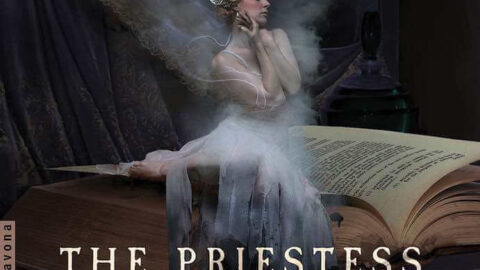Issues of identity, sexuality, consent, and growth pervade The Priestess of Morphine: The Lost Writings of Marie-Madeleine (Navona Records), a work by composer Rosśa Crean and librettist Aiden K. Feltkamp that occupies an artistic space between opera and song cycle. Scored for two sopranos, violin (Alex Giger), cello (Stephen Hudson), vibraphone (Ben Zucker), and waterphone (Crean), The Priestess of Morphine tells the fascinating historical story of Gertrude Günther, a Jewish baroness in the Third Reich with many identities–she was at once a noblewoman, a wife, an addict, a Nazi prisoner, and the lesbian erotic poet Marie-Madeleine.
The work is wrought with thoughtful and deliberate contradictions that add to the displacement of identity, and therefore the listener’s sense of musical center. To start, Crean and Feltkamp have termed the piece a monodrama, but two singers (Jessie Lyons and Katherine Bruton) each represent a different personality of the same woman: Lyons sings Gertrude, and Bruton sings Marie-Madeleine. The singers’ timbres are so similar that it is difficult to distinguish between their voices. This certainly highlights the duality held in one woman, but it also forces the listener into a precarious state of listening; we cannot trust our ears and strain to discern individual sounds from one another.
Feltkamp’s libretto–adapted from psychopharmacologist Ronald K. Siegel’s translations of Marie-Madeleine’s poems–assists with this task. They construct an interconnected narrative between Gertrude and Marie-Madeleine that presents each woman’s character and desires. Gertrude’s text is educated and clinical, while Marie-Madeleine’s is reactive and colorful. Formally, the two women alternate songs in the opera: in the first track, “The Awakening,” Gertrude begins by introducing the idea of forensic science, then identifies Marie-Madeleine and herself as the same person. Immediately following (“In Salvation and in Sin”), Marie-Madeleine describes a powerful dream tilting between eroticism and horror.

In “Morphine,” Gertrude explains the opiate qualities of the poppy flower. Beginning with an a cappella solo voice, Crean forces both singer and listener to be vulnerable in their experience of this music. When instruments join the voice, the texture is still sparse until the chromatic descent into Gertrude’s retelling of her first encounter with morphine, one that did not include her consent, and a sonic representation of her altered state of consciousness. Gertrude’s language remains scientific while the music negotiates microtones and extended techniques in accompanying instruments and voices.
In “Tumbling,” Marie-Madeleine once again tells the listener of a dream-like state. Lines of her text, such as “I am always – still! – so long! – stuck in this cursed place,” makes the listener question what’s real: is this cursed place Marie-Madeleine’s morphine high, or is it Gertrude’s imprisonment by the Nazis? The strings supply a microtonal portamento punctuated by harmonics, while Marie-Madeleine sings in an almost sprechstimme style. Both the accompanying ensemble and the voices explore the boundaries of musical identity that reflect the liminal space presented in the text: through extended techniques and unfamiliar sonorities, we hear pitches and timbres that challenge our conventional understanding of opera.
In the penultimate number, “Harvest Song,” Gertrude and Marie-Madeleine sing an unaccompanied duet. Gertrude begins as Marie-Madeleine joins in imitative counterpoint, but she soon deviates, interjecting with hisses, whispers, and microtonal slides. They sing a brief section for the first time truly together during which Gertrude fully transforms into Marie-Madeleine, and we can understand this gesture as Gertrude’s death. Both voices adopt Marie-Madeleine’s textural vocalizations, then sing in unison on stratified octaves to show transformation from the worldly personality (Gertrude) into the other-worldly (Marie-Madeleine). They end the song with a canon and return to lyrics from the beginning, “Poppies are monocarpic – they die after flowering.”

“The Flower of Oblivion” is sung by Marie-Madeleine, but that is not clear. The text reflects her previous utterances: fervent and emotional, but the music sounds more like Gertrude at the beginning of the monodrama. The straightforward but sophisticated music paired with volatile text contradict one another. Because the two singers’ timbres are so closely matched, the listener wonders from whom we are hearing. There’s a somberness when we realize that only in death can Gertrude’s identities converge. The last lines of the text capture this experience deftly: “I’ll find the deepest dark within that dream where we’re united forever.” This obfuscation of character works well on a recording, but because of the delicate pairing of Gertrude’s music with Marie-Madeleine’s text, our understanding of the character transformation would work equally well onstage.
Despite its decided unpredictability in musical and textual style, Crean and Feltkamp’s complex work is thrilling and engaging to listen to. The work reflects our current moment and will resonate with a vast range of listeners as we, like Gertrude, continue to struggle for affirmation of our identities. The Priestess of Morphine allows listeners an emotional catharsis as we consider how, and when, we might achieve this acceptance.
I CARE IF YOU LISTEN is an editorially-independent program of the American Composers Forum, funded with generous donor and institutional support. Opinions expressed are solely those of the author and may not represent the views of ICIYL or ACF.
A gift to ACF helps support the work of ICIYL. For more on ACF, visit the “At ACF” section or composersforum.org.
























